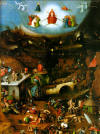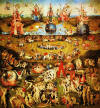Search: Symbolism: Artists Alphabetically Artists by Country Artists by Century Artists by Movement
Hieronymus Bosch
1450-1516
One of the Greatest Painters Of All Time
Northen Renaissance Netherlandish painter
The most intriguing artist in the history of the world
Hieronymus Bosch was Born as Jeroen van Aken
although he signed his paintings as Jheronimus Bosch in order to bring
recognition to his birthplace, Hertogenbosch, a small town in
the province of North Brabant in Holland. Bosch made himself a name as
a visionary. He had a taste for the poetic and his
use of symbols are secretive hints and glances into the mysterious
world that lies behind the painted one. All those grimacing images
which were customary in medieval decorative art, especially in the
stone ornaments of Gothic cathedrals and the wood carvings of choir
stalls, were transferred by him to panel painting. He is especially
fond of giving fishes the wings of bats and of creating
strange monstrosities by commingling the forms of animals and vessels.
His practice of them the form of an alter is characteristic of their
significance. Whether he presents the seven Deadly Sins, the Ship of
Fools, the Pleasures of the World or the Temptation of St. Anthony, it
is always a sermon beginning with the fall of man and ending with hell.
At a time when gluttony and wild sensuality followed upon the
mortifications of the flesh, he swung the heavy moral club and
practiced the art of " hanging people in colors". Bosch
painted the same Capuchin sermons with which Sebastian Brandt, Geiler
von Kaisersperg, and Thomas Murner regaled their listeners.
Like Quentin Massys, he was also fond of painting biblical scenes in
half-size figures, in which he appears as a sharp and malicious
physiognomist. His line engravings, Gluttony, Avarice, and Drunkenness
are further examples in which fantastical genre painting, though under
an allegorical cloak, ventures forth. Themes like the dance of the
cripples, surgical operations, and quack doctors became especially
popular in painting.
During his lifetime Hieronymus
Bosch was a celebrated and respected master painter. His work was
commissioned and collected by royalty, the church and wealthy patrons.
It is a foolish myth to believe that the intellectual Boshe
spent his entire artistic career in the small Dutch town of
Hertogenbosch. It is documented that he was commissioned by
Philip the Handsome and to suppose the powerful King came to some rude
cottage to sit for a portrait is absurd.
Hieronymus was a widely traveled, highly educated man. Boshe was extremely
influential within his circle of local painters and fine
craftsmen. While it is true that Hieronymus was a
member of a extreme religious society called the Brotherhood of Mary,
it is also true that everyone of distinction belonged to this
society. He received a number of financially lucrative commissions from
the Brotherhood. There is speculation that Hieronymus may have been a member of the
notorious Brethren of the Free Spirit, also known as Adamites, an
obscure cult which practiced free love, wanton promiscuity and same sex
encounters in an effort to achieve the purity of the Adam and Eve
before the fall.
It is understandable that later generations accused him of
heresy because they didn't comprehend his great visionary works.
Important Words, People, Phrases, Characteristics related to the Northern Renaissance Art Movement - allegorical painting, rebirth, invention of oil painting, Hieronymus Bosch, Limbourg Brothers, Desiderius Erasmus, Robert Campin, Jan Van Eyck, Jean Fouquet, Albrecht Dürer, Johannes Gutenberg, Johann Reuchlin, Martin Luther, rise of the merchant class, Protestant Reformation, Calvinisim, glazing, impasto, scriptorium, illuminator, invention of the printing press, woodcuts, engravings, Antwerp School, Guild of Saint Luke, commerce, Flemish School, Northern Europe, Antwerp School, Flanders, Bruges, renewed interest in classical learning, mythological scenes, genre painting, landscapes, portraits, moralizing overtones, human vices, lust, paradise, spirituality, piousness, living a simple life, reform, Human Reasoning, tradesmen at work, idyllic scenes of peasants, playing games, feasting, linear perspective, \Heliocentric Theory, humour, satire, spiritually significant, illuminated manuscript, idealized biblical themes, scriptorium, emotion, illuminator, iconoclast, Age of Discovery, Virgin and Child, axonometric drawing, curiosity about the natural world, realistic use of colours and light, Old Testament stories, Gospel parables, The Blackdeath, Christian symbolism
☼☼☼☼☼
Guest Comments:
Hieronymus
Bosch's use of symbolism does not diverge much from other Medieval
artists. He illustrates malicious demons cavorting about whilst
engaging in immoral behavior. I wonder how the church reacted to this
work? One wants to look away but finds himself pulled into the erotic
imagery. Bosch's art is exceptional for the distinctive and complex
nightmarish world he rendered with such incredible skill. -- Cherri O'
Brian, Charleston, South Carolina
☼☼☼☼☼
Hieronymus Bosch
is rare in that he depicted his revelations and prophecies for the
world to see. I believe his work has survived for a reason. Bosch's
phantasmagoric images of rapture and torment have a extraordinary
importance in the 21st century. As an artist he exhibited a vision that
was grim, immeasurable in scope and divine. -- Ella R. Rissole, NYC,
New York
☼☼☼☼☼
Hieronymus's
paintings are an intricate and rich matrix of both mystery and
discovery. His work is "internally" directed and can only be described
as 'fantastic' and 'visionary'. Some figures are carefully rendered;
others evolve more playfully and seem thrown into the composition. I
have 5 Heironymus Bosch prints and have found that they change each
time I look at them. -- Captain Raymont Timothy Grimm, Denver, Colorado
© HistoryofPainters.com If you like this page and wish to share it, you are welcome to link to it, with our thanks. updated 3/7/2017

